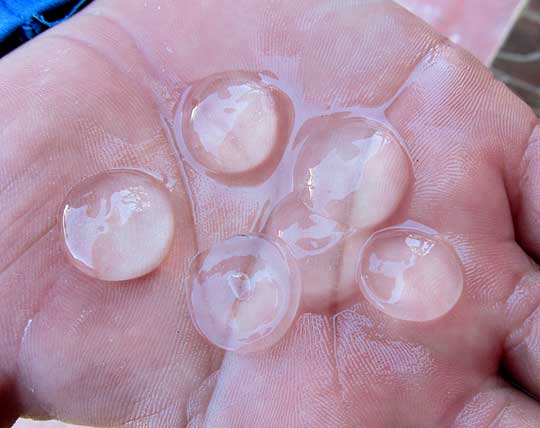Excerpts from Jim Conrad's
Naturalist Newsletter
from the April 5, 2015 Newsletter issued from Río Lagartos, on the Yucatan Peninsula's northern coast (~N21.60°, ~W88.16°), Yucatán state, MÉXICO
SEA GOOSEBERRIES
Jorge with a big smile appeared at my door carrying a white, 10-liter bucket sloshing with cloudy seawater, and I figured he'd found something special in the estuary during one of his fly-fishing or flamingo-watching tours. He held the bucket out so I could peep inside but I saw nothing but swirling, slightly cloudy water. On my hands and knees, still I could see nothing. Finally Jorge had to reach into the bucket and retrieve some of his discoveries, six of which you can see in the palm of his hand below:

"Sometimes during the year, huge numbers of these turn up on the beach, and I've always wanted to know what they were. So, what are they?" he asked.
I'd never seen or heard of anything like them. Picking one up and holding it against the blue sky, trying to see internal structures, I thought it might be something like a jellyfish, because it was gelatinous. Below, you can see what I saw:

Nothing there made sense. It was simply a lens-shaped glob of gelatin with irregular shadows, bubbles and clouds inside, and there were no tiny eggs. I hardly knew where to begin the identification process. This was a real mystery.
With Google Image Search I searched on the keywords "marine gelatinous lenses" and came up with links to contact lens providers. Changing "lenses" to "disks" got me a worse hodgepodge of things. On the third try, however, "marine gelatinous beach" I got a California beachcomber's blog describing all the different kinds of "jelly blobs" he'd found on the beach, and one of his blobs looked like our mystery objects.
He labeled them sea gooseberries of the genus Pleurobrachia, and described them as "... a type of comb jelly -- jellies with running lights." He said that comb jellies have spherical bodies from which dangle two long tentacles with sticky, non-stinging cells used for catching tiny aquatic prey. Individual sea gooseberries are both male and female, or hermaphroditic, and prolific.
Pictures of Pleurobrachia species show what look like tiny jellyfish, except that the dangling tentacles number only two, and the tentacles are branched. These differences are so profound that sea gooseberries aren't thought of as jellyfish. They're a whole different kind of thing, comb jellies.
Pictures on the Internet portray elegant, fragile-looking, complex little animals nothing like the simple gelatinous disks Jorge brought me in his bucket. But the California beachcomber had explained that the disks that turn up on beaches are just the remains of sea gooseberries. Wave action has beaten them against the sand and aquatic plants, swirled and tumbled them, until nothing is left but an eroded, gelatinous blob.
A problem with deciding that our Yucatan blobs were Pleurobrachia comb jellies was that Pleurobrachia species are mainly known in the Pacific. It took awhile to find reference to them occurring in the Gulf of Mexico or Caribbean, and then no species was named. Apparently, sea gooseberries haven't been studied in our area.
The JelliesZone.Com website is produced by David Wrobel, a jellyfish specialist now working as a data analyst. You can tell he really likes the gelatinous corner of the Animal Kingdom, so I sent our pictures to him to see if he thought they were sea gooseberries, despite being found in the Gulf of Mexico.
He replied that "the photos are consistent with Pleurobrachia," though he said he couldn't be 100% sure just seeing pictures, especially since no internal structures are visible. But he, like me, couldn't think of any other likely possibilities, so he was willing to go with Pleurobrachia.
So, that's what we'll call them: Sea Gooseberries, genus PLEUROBRACHIA -- but we have just their remains.
To get a fix on how unrelated the sea gooseberries are to jellyfish, it's enough to reflect that the Animal Kingdom is composed of around 35 phyla. All animals with backbones -- more technically, with a "notochord" -- from fish to birds and humans, belong to the single phylum Chordata. Segmented worms belong to the Annelid Phylum, and sponges to another. In other words, to belong to different phyla, you have to be profoundly different from all other things. And sea gooseberries belong to the phylum Ctenophora, while jellyfish belong to the phylum Cnidaria.